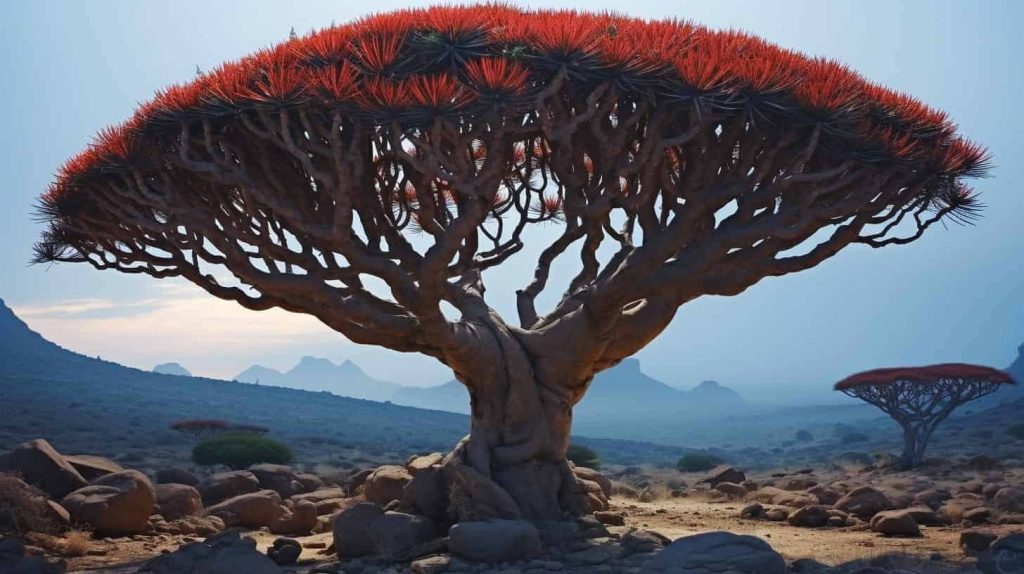
The Enigmatic Dragon Blood Tree: A Living Legend

Description
The Dragon Blood Tree (Dracaena cinnabari) is one of the most fascinating and unique trees in the world, native to the island of Socotra in Yemen. This ancient tree, with its dense, umbrella-shaped crown, looks like something straight out of a fantasy novel. It thrives in dry, arid conditions, making it a perfect fit for Socotra’s rugged landscape.
The name “Dragon Blood Tree” comes from the deep red resin that oozes from its bark when cut. This resin, which looks like blood, has been treasured for centuries for its medicinal, artistic, and magical properties.
Color and Appearance
The tree has an unmistakable shape, with a thick, umbrella-like canopy that allows it to capture moisture from the air. The canopy, made up of numerous stiff, clustered leaves, creates a shaded environment that helps the tree survive in its hot, dry habitat.
The bark is greyish-brown, with deep cracks that give it a weathered look. However, what sets this tree apart is the bright, red sap that flows from its bark, known as “dragon’s blood.” This rich scarlet sap has made the tree legendary across cultures, believed to hold magical powers.
Uses
The Dragon Blood Tree has been highly valued for its medicinal and cultural uses, making it a cornerstone of Socotran life for centuries:
- Dragon’s Blood Resin: This crimson resin has been used historically as a dye, a medicine, and even in alchemy. It’s still used today in varnishes for violins and other instruments.
- Medicinal purposes: The resin has been traditionally used to treat wounds, ulcers, and respiratory ailments. Its antibacterial properties make it effective for wound healing and skin treatments.
- Dye and Incense: In ancient times, the resin was used as a dye for textiles, and it was also burned as incense in religious and spiritual ceremonies.
- Cosmetics: Some societies use the resin in beauty rituals, believing it to have skin-rejuvenating and anti-aging properties.
Fun Facts
- Mythical Origins: According to legend, the Dragon Blood Tree sprang from the blood of a dragon that was slain by an elephant during a fierce battle. The tree’s crimson sap is said to be the dragon’s blood, which gives it both its name and its mystical reputation.
- Umbrella Shape: The umbrella-like structure of the tree helps it conserve water by reducing evaporation, a key adaptation for surviving the harsh environment of Socotra Island.
- Endemic to Socotra: The Dragon Blood Tree is found only on the island of Socotra, making it one of the many unique species that have evolved on this isolated island, often referred to as the “Galápagos of the Indian Ocean.”
- Ancient Resin Trade: In antiquity, the resin was highly sought after by traders and was considered more valuable than gold. It was exported to the Mediterranean, India, and China, where it was used in traditional medicine and rituals.
Remedies
For centuries, dragon’s blood resin has been prized for its medicinal properties. Here are some traditional uses:
- Wound Healing: The resin is applied topically to speed up the healing of cuts and wounds. It acts as a natural antiseptic, preventing infections.
- Digestive Aid: In some cultures, the resin is taken internally to treat digestive issues, such as diarrhea and ulcers.
- Anti-inflammatory: The resin has anti-inflammatory properties and has been used to soothe arthritis pain and reduce swelling.
- Respiratory Health: Inhaling the fumes of dragon’s blood resin, or using it in tinctures, is believed to help clear respiratory infections and soothe coughs.
Conservation Status
The Dragon Blood Tree faces a number of threats due to overharvesting of its resin and habitat destruction. Climate change is also impacting the tree’s natural environment, as Socotra becomes drier and less hospitable. Conservation efforts are underway to protect this ancient tree, but the future remains uncertain for this symbol of Socotra’s biodiversity.
Symbolism
The Dragon Blood Tree holds deep symbolic significance for the people of Socotra and beyond. It represents endurance, healing, and the mystical connection between nature and mythology. Its striking appearance and the legend surrounding its red sap have made it a powerful emblem of mystery and magic in various cultures.